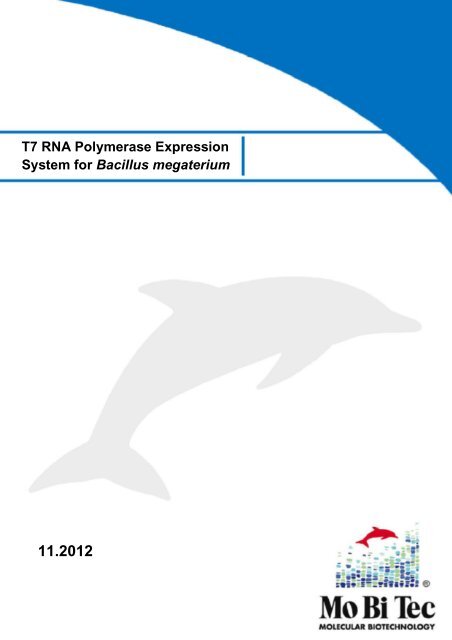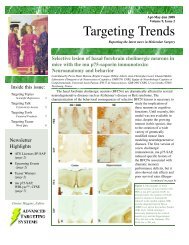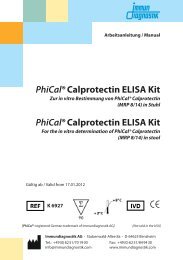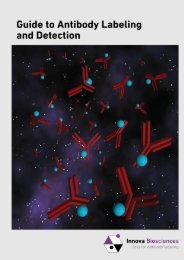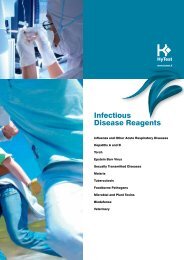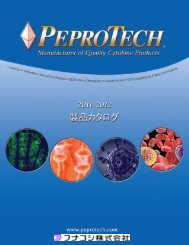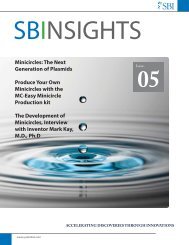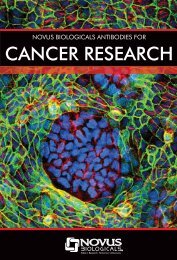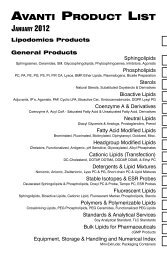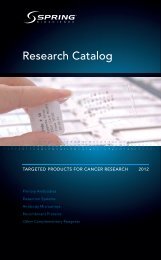T7 RNA Polymerase Expression System for Bacillus megaterium
T7 RNA Polymerase Expression System for Bacillus megaterium
T7 RNA Polymerase Expression System for Bacillus megaterium
Create successful ePaper yourself
Turn your PDF publications into a flip-book with our unique Google optimized e-Paper software.
© MoBiTec GmbH, 2012 Page 1<br />
<strong>T7</strong> <strong>RNA</strong> <strong>Polymerase</strong> <strong>Expression</strong><br />
<strong>System</strong> <strong>for</strong> <strong>Bacillus</strong> <strong>megaterium</strong><br />
11.2012<br />
MoBiTec GmbH, Germany � Phone: +49 551 70722 0 � Fax: +49 551 70722 22 � E-Mail: info@mobitec.com � www.mobitec.com
© MoBiTec GmbH, 2012 Page 2<br />
Content<br />
1. Introduction .......................................................................................................................... 3<br />
1.1. General features of <strong>Bacillus</strong> <strong>megaterium</strong>....................................................................................3<br />
1.2. <strong>Bacillus</strong> <strong>megaterium</strong> as expression host .....................................................................................3<br />
1.3. General features of the <strong>T7</strong> <strong>RNA</strong> polymerase expression system ................................................4<br />
2. Summary of advantages......................................................................................................... 5<br />
3. Application examples............................................................................................................. 6<br />
4. Protocols............................................................................................................................... 7<br />
4.1. Cloning the DNA fragment of interest.........................................................................................7<br />
4.2. General remarks on the handling of B. <strong>megaterium</strong>...................................................................7<br />
4.3. Trans<strong>for</strong>mation of B. <strong>megaterium</strong> protoplasts............................................................................7<br />
4.4. Protein production ....................................................................................................................9<br />
5. Materials..............................................................................................................................11<br />
6. Vector maps .........................................................................................................................13<br />
7. References ...........................................................................................................................15<br />
8. Order In<strong>for</strong>mation, Shipping and Storage ..............................................................................17<br />
9. Contact and Support.............................................................................................................18<br />
MoBiTec GmbH, Germany � Phone: +49 551 70722 0 � Fax: +49 551 70722 22 � E-Mail: info@mobitec.com � www.mobitec.com
© MoBiTec GmbH, 2012 Page 3<br />
An efficient alternative to common <strong>Bacillus</strong><br />
<strong>megaterium</strong> expression systems:<br />
High yield protein expression with the <strong>T7</strong> <strong>RNA</strong><br />
polymerase expression system<br />
MoBiTec offers this dual plasmid expression system as an easy-to-handle solution with<br />
pretrans<strong>for</strong>med <strong>Bacillus</strong> <strong>megaterium</strong> protoplasts (MS941 carrying p<strong>T7</strong>-<strong>RNA</strong>P) ready <strong>for</strong><br />
trans<strong>for</strong>mation and Escherichia coli / <strong>Bacillus</strong> <strong>megaterium</strong> shuttle vectors.<br />
1. Introduction<br />
1.1. General features of <strong>Bacillus</strong> <strong>megaterium</strong><br />
First described over 100 years ago, B. <strong>megaterium</strong> has recently been gaining more and<br />
more importance in scientific as well as industrial applications. The source of its<br />
significant name "<strong>megaterium</strong>" is its large size of the vegetative cells (over 10 μm) and its<br />
spores. The capability of sporulation has made B. <strong>megaterium</strong> an important tool <strong>for</strong><br />
examining spore-mediated disease and cell development.<br />
B. <strong>megaterium</strong> is able to grow on a wide variety of carbon sources and thus has been<br />
found in many ecological niches such as waste from meat industry or petrochemical<br />
effluents. Also, the degradation of persistent insecticides by B. <strong>megaterium</strong> has been<br />
documented (Saxena et al., 1987; Selvanayagam and Vijaya, 1989) offering potential<br />
applications as detoxifying agent. One of the genetic regulatory elements <strong>for</strong> carbon<br />
utilization is the xylose operon. It has been described by Rygus and Hillen (1991) and is<br />
used in the expression system MoBiTec is offering in this kit.<br />
Further, several B. <strong>megaterium</strong> proteins are of importance. For example, a family of P450<br />
cytochrome monooxygenases is similar to eukaryotic P450 playing a role in many<br />
diseases. Industrial applications of enzymes excreted by B. <strong>megaterium</strong> are diverse,<br />
starting from amylases used in bread industry to penicillin amidase which is used <strong>for</strong> the<br />
generation of new synthetic antibiotics.<br />
An overview about the features of this unique organism is given in review articles as<br />
"Prime time <strong>for</strong> <strong>Bacillus</strong> <strong>megaterium</strong>" (Vary, 1994), “A short story about a big magic bug”<br />
(Bunk et al., 2010) and “<strong>Bacillus</strong> <strong>megaterium</strong> - from simple soil bacterium to industrial<br />
protein production host“ (Vary et al., 2007).<br />
1.2. <strong>Bacillus</strong> <strong>megaterium</strong> as expression host<br />
In molecular biology, B. <strong>megaterium</strong> has been proven to be an excellent host <strong>for</strong> the<br />
expression of non-homologous DNA. Cloning vectors of the B. <strong>megaterium</strong> system<br />
(derivatives of the original pWH1520 (Rygus and Hillen, 1991; Malten et al., 2006;<br />
Biedendieck et al., 2007)) rely on the above mentioned xylose inducible expression<br />
system used as regulatory element. Further, a <strong>T7</strong> <strong>RNA</strong> polymerase dependent promoter<br />
and terminator were introduced into a compatible vector.<br />
MoBiTec GmbH, Germany � Phone: +49 551 70722 0 � Fax: +49 551 70722 22 � E-Mail: info@mobitec.com � www.mobitec.com
© MoBiTec GmbH, 2012 Page 4<br />
In contrast to other bacilli strains B. <strong>megaterium</strong> has the advantage, that no alkaline<br />
protease is present. This fact enables excellent production and secretion of <strong>for</strong>eign<br />
proteins without degradation (Meinhardt et al., 1989; Rygus and Hillen, 1991). In addition,<br />
due to its Gram-positive character there are no endotoxins found in the cell wall.<br />
Furthermore, B. <strong>megaterium</strong> is able to stably maintain several extra-chromosomal DNA<br />
elements in parallel, so we can offer you this expression kit with two in parallel-replicating<br />
plasmids.<br />
1.3. General features of the <strong>T7</strong> <strong>RNA</strong> polymerase expression system<br />
The <strong>T7</strong> <strong>RNA</strong> polymerase (<strong>T7</strong> <strong>RNA</strong>P) expression system originates from the<br />
bacteriophage DNA-dependent <strong>RNA</strong> polymerase. In 1985, the first described <strong>T7</strong> <strong>RNA</strong>P<br />
expression system was developed <strong>for</strong> Escherichia coli (Tabor and Richardson, 1985).<br />
Advantages of this system are the stringent selectivity and the high transcriptional activity<br />
so that it is possible to lead to a saturation of the protein-synthesizing machinery in E.<br />
coli. Consequently, 50% or more of the total cellular protein can consist of the desired<br />
protein (Studier and Moffatt, 1986).<br />
The <strong>T7</strong> <strong>RNA</strong>P expression system <strong>for</strong> B. <strong>megaterium</strong> combines the features of this system<br />
in E. coli with the above mentioned regulation by the xylose operon. This system is based<br />
on two parallel-replicating plasmids: p<strong>T7</strong>-<strong>RNA</strong>P and pP<strong>T7</strong> (Gamer et al. 2009). In addition<br />
to the t7 rnap gene under control of the strong xylA promoter p<strong>T7</strong>-<strong>RNA</strong>P contains the<br />
genes <strong>for</strong> ampicillin and chloramphenicol resistance <strong>for</strong> easy selection in E. coli (Amp R )<br />
and B. <strong>megaterium</strong> (Cm R ). pP<strong>T7</strong> is responsible <strong>for</strong> the <strong>T7</strong> <strong>RNA</strong>P-dependent expression of<br />
the target gene. Downstream of the <strong>T7</strong> promoter it comprises a multiple cloning site with<br />
ten unique restriction enzyme cleaving sites. Additionally the plasmid comprises two<br />
resistances against ampicillin (in E. coli) and tetracycline (in B. <strong>megaterium</strong>).<br />
Next to the pP<strong>T7</strong> vector, we offer an expression vector that leads to secretion of<br />
expressed proteins into the surrounding medium. pP<strong>T7</strong>-SPLipA provides the n-terminal<br />
signal peptide LipA that uses the Sec-pathway <strong>for</strong> protein secretion.<br />
Furthermore, a great obstacle in protein production and engineering, the cloning of genes<br />
coding <strong>for</strong> proteins that are toxic to the cloning host E. coli, can be overcome by means<br />
of the <strong>T7</strong> expression system due to the absence of <strong>T7</strong> <strong>RNA</strong>P in the cloning host.<br />
For your convenience MoBiTec offers B. <strong>megaterium</strong> protoplasts pretrans<strong>for</strong>med with<br />
p<strong>T7</strong>-<strong>RNA</strong>P, so that you just have to insert your gene of interest into pP<strong>T7</strong> and trans<strong>for</strong>m<br />
the pretrans<strong>for</strong>med protoplasts with this plasmid.<br />
For control purposes the gfp-expressing vector pP<strong>T7</strong>-GFP is included in the kit.<br />
MoBiTec GmbH, Germany � Phone: +49 551 70722 0 � Fax: +49 551 70722 22 � E-Mail: info@mobitec.com � www.mobitec.com
© MoBiTec GmbH, 2012 Page 5<br />
2. Summary of advantages<br />
� B. <strong>megaterium</strong> is not pathogenic<br />
� No endotoxins are found in the cell wall<br />
� Tightly regulated and efficiently inducible xylA operon (up to 350-fold)<br />
� Stable, high yield protein production<br />
� Extracellular protein production possible with pP<strong>T7</strong>-SPlipA<br />
� No indication of proteolytic instability even up to 5 h after induction, since alkaline<br />
proteases such as e.g. in B. subtilis are not produced<br />
� Suited <strong>for</strong> small to industrial-scale protein production<br />
� Tightly regulated and efficiently inducible xylA operon / <strong>T7</strong> <strong>RNA</strong> polymerase<br />
� Suitable <strong>for</strong> cloning of toxic proteins in E. coli<br />
� Easy trans<strong>for</strong>mation by use of pretrans<strong>for</strong>med B. <strong>megaterium</strong> protoplasts<br />
� Control vector with GFP sequence included in the kit<br />
MoBiTec GmbH, Germany � Phone: +49 551 70722 0 � Fax: +49 551 70722 22 � E-Mail: info@mobitec.com � www.mobitec.com
© MoBiTec GmbH, 2012 Page 6<br />
3. Application examples<br />
As a model <strong>for</strong> the recombinant<br />
overproduction of intracellular proteins<br />
Gamer et al. (2009) used the green<br />
fluorescent protein (GFP) from Aequoria<br />
victoria. They showed that GFP was found<br />
to be the dominant cytosolic protein 1.5<br />
hours after the induction of t7 expression<br />
induced by xylose. In comparison to a<br />
common used B. <strong>megaterium</strong> xyloseinducible<br />
expression system they found<br />
5.3 times more GFP with the <strong>T7</strong> <strong>RNA</strong>P<br />
expression system (Fig. 1) compared to<br />
the native xylose inducible one. The<br />
overall productivity was more than six<br />
times enhanced (12.8 mg l -1 h -1 with the <strong>T7</strong><br />
<strong>RNA</strong>P expression system - 2mg l -1 h -1 with<br />
the xylose-inducible system).<br />
Treatment of the B. <strong>megaterium</strong> host cells<br />
by rifampicin that is a selective inhibitor of<br />
bacteria DNA-dependent <strong>RNA</strong>polymerases<br />
leads to a stabilization of the<br />
Fig. 1 Comparison of GFP amounts produced<br />
by variant expression systems. GFP produced<br />
by B. <strong>megaterium</strong> carrying the common xyloseregulated<br />
plasmid pRBBm34 (square), B.<br />
<strong>megaterium</strong> trans<strong>for</strong>med with the <strong>T7</strong> expression<br />
system plasmids (circle) and B.<strong>megaterium</strong> with<br />
the <strong>T7</strong> expression system plasmids treated with<br />
rifampicin. (Gamer et al., 2009)<br />
<strong>T7</strong> <strong>RNA</strong>P and to constant amounts of overproduced protein. However, the positive<br />
effects on cytosolic amounts are contrasted by growth defects caused by the rifampicin<br />
treatment. On the other hand rifampicin treatment led to an increase of 31% in volumetric<br />
levansucrase activity 8 hours after induction.<br />
Notably, limitations were shown in the overproduction of the extracellular levansucrase<br />
from Lactobacillus reuteri. Due to yet unknown reasons, the protein with N-terminal signal<br />
peptide LipA <strong>for</strong> the export via the Sec-pathway was not found in higher amounts<br />
compared to the production with a common used B. <strong>megaterium</strong> xylose-inducible<br />
expression system (Gamer et al., 2009).<br />
MoBiTec GmbH, Germany � Phone: +49 551 70722 0 � Fax: +49 551 70722 22 � E-Mail: info@mobitec.com � www.mobitec.com
© MoBiTec GmbH, 2012 Page 7<br />
4. Protocols<br />
4.1. Cloning the DNA fragment of interest<br />
The pP<strong>T7</strong> E. coli / B. <strong>megaterium</strong> shuttle vector is supplied as lyophilized DNA. Follow<br />
standard protocols <strong>for</strong> propagation of the plasmid in E. coli, plasmid mini preparation,<br />
restriction endonuclease cleavages and ligation of the DNA fragment of interest into the<br />
vector (Sambrook and Russell, 2001). After ligation of the insert, the vectors should be<br />
propagated in E. coli (amp r ) be<strong>for</strong>e trans<strong>for</strong>ming the <strong>Bacillus</strong> protoplasts (tet r , cm r ).<br />
4.2. General remarks on the handling of B. <strong>megaterium</strong><br />
Strains will grow well on rich media such as LB medium, plates and liquid, at 30 °C and<br />
37 °C. Make sure to aerate liquid cultures well by vigorous agitation in baffled shaking<br />
flasks.<br />
We found MS941 and derived strains to be asporogenic on common medium - they will<br />
die on plates, kept at 4 °C, within two weeks, so prepare glycerol stocks (30 % w/v) as a<br />
backup and streak the working cultures on fresh plates every 7 - 10 days.<br />
Positive clones carrying the plasmids of interest can be selected by adding 10 µg/ml<br />
tetracycline and 4.5 µg/ml chloramphenicol to the growth medium.<br />
To prove successful overexpression of the target gene harvest small samples of the<br />
culture just be<strong>for</strong>e and at intervals after induction of recombinant gene expression with<br />
xylose. To obtain crude extracts <strong>for</strong> gel analysis, the bacilli have to be lysed using<br />
lysozyme. Simple boiling of cells in sample buffer (Laemmli, 1970), which is quite<br />
convenient <strong>for</strong> E. coli, does not work with B. <strong>megaterium</strong>.<br />
4.3. Trans<strong>for</strong>mation of B. <strong>megaterium</strong> protoplasts<br />
For recombinant protein production B. <strong>megaterium</strong> protoplasts pretrans<strong>for</strong>med with p<strong>T7</strong>-<br />
<strong>RNA</strong>P are trans<strong>for</strong>med with the plasmids (pP<strong>T7</strong>-derivatives) coding <strong>for</strong> the protein of<br />
interest. After trans<strong>for</strong>mation it is advisable to screen at least three different clones <strong>for</strong><br />
protein production as the yield can vary among different clones.<br />
Since B. <strong>megaterium</strong> cannot easily be trans<strong>for</strong>med naturally, MoBiTec conveniently<br />
provides protoplasts of B. <strong>megaterium</strong>, which are ready <strong>for</strong> trans<strong>for</strong>mation. MoBiTec<br />
produces these protoplasts every second month. They can be used at least 2 months<br />
after date of arrival and have to be stored at -80 °C. The protoplast suspension is<br />
supplied in 5 aliquots of 0.5 ml each to prevent multiple freezing and thawing of<br />
protoplasts that are not used immediately. One aliquot is provided per trans<strong>for</strong>mation. It<br />
is advisable to use two of the vials <strong>for</strong> the control experiments as described below.<br />
Below you can find a standard protocol <strong>for</strong> trans<strong>for</strong>mation of protoplasts.<br />
MoBiTec GmbH, Germany � Phone: +49 551 70722 0 � Fax: +49 551 70722 22 � E-Mail: info@mobitec.com � www.mobitec.com
© MoBiTec GmbH, 2012 Page 8<br />
Control Experiments:<br />
1. Negative control: protoplasts without DNA<br />
Note: Each lot of protoplasts undergoes this test during our quality control as well.<br />
This is the control demonstrating that the protoplasts have not been contaminated but<br />
vital. Split the cells after trans<strong>for</strong>mation and incubation. You should get an empty plate<br />
without any colonies on the antibiotic (here: tetracycline/chloramphenicol) plate but a<br />
layer of cells on just chloramphenicol plates.<br />
2. Positive control: protoplasts trans<strong>for</strong>med with empty pP<strong>T7</strong> plasmid (without insert) –<br />
not included in the kit! (alternatively with pP<strong>T7</strong>-GFP)<br />
This is your control <strong>for</strong> a successful trans<strong>for</strong>mation and should yield lots of colonies on<br />
antibiotic (here: tet/cm) plates. If this trans<strong>for</strong>mation works well, but you have problems<br />
with the plasmid containing your insert of interest, the problem most probably is<br />
associated with your construct.<br />
Essential buffers are listed in chapter 5.<br />
Trans<strong>for</strong>mation procedure:<br />
1. Combine 500 μl of protoplast suspension and 3-5 μg of Plasmid DNA (DNA should be<br />
purified using a commercial preparation kit. Elute the DNA from the column using<br />
water) in a 15 ml tube, one <strong>for</strong> each trans<strong>for</strong>mation<br />
2. Add 1.5 ml of PEG-P (room temperature RT), mix gently and incubate <strong>for</strong> 2 minutes at<br />
RT<br />
3. Add 5 ml SMMP, mix by rolling the tube carefully<br />
4. Harvest cells by gentle centrifugation (in e.g. a Heraeus Biofuge/Minifuge at 3,000<br />
rpm (1,300 x g) <strong>for</strong> 10 minutes at RT), pour off supernatant immediately after<br />
centrifugation, supernatant does not have to be removed completely.<br />
(Note: do not check <strong>for</strong> a pellet - most of the time there will be none visible)<br />
5. Add 500 μl of SMMP to the rest of the supernatant<br />
6. Incubate at 30 °C or 37 °C <strong>for</strong> 90 minutes with gentle shaking or rolling of tubes (max.<br />
100 rpm) or <strong>for</strong> 45 min without followed by 45 min with shaking (300 rpm)<br />
7. Prepare 2.5 ml aliquots of CR5-top agar in sterile tubes, one <strong>for</strong> each trans<strong>for</strong>mation<br />
8. After outgrowth add al cells to 2.5 ml top agar, mix gently by rolling the tube between<br />
both hands (do not vortex!) and pour onto a prewarmed plate of LB containing the<br />
desired antibiotics<br />
9. Incubate overnight at 30 °C or 37 °C - expect colonies of varying diameter because<br />
some will be covered with agar and others have easier access to air<br />
(Note: the colonies on the top of the agar surface will be shiny)<br />
10.Streak several different clones on fresh plates within two days<br />
Note: Protein production may vary among clones due to yet unknown reasons.<br />
MoBiTec GmbH, Germany � Phone: +49 551 70722 0 � Fax: +49 551 70722 22 � E-Mail: info@mobitec.com � www.mobitec.com
© MoBiTec GmbH, 2012 Page 9<br />
4.4. Protein production<br />
I. Test protein production<br />
1. Grow the recombinant B. <strong>megaterium</strong> cells in LB medium including antibiotic (here:<br />
tet/cm) in baffled shaking flasks to an optical density at 578 nm (OD578nm) of 0.3 - 0.4<br />
at 37 °C and strong shaking (250 rpm)<br />
2. Take a sample as control be<strong>for</strong>e induction<br />
3. Induce the xylose inducible promoter by the addition of 0.5 % of (D)-xylose<br />
4. Incubate at 37 °C and strong shaking (250 rpm)<br />
5. Withdraw samples every 30 to 60 minutes until an OD578nm of around 4 to 5<br />
(depending on the growth medium) is reached (now, cells have entered the stationary<br />
phase). Take samples <strong>for</strong> OD578nm-measurement and protein analysis. For<br />
extracellular protein analysis take 2 ml of cell culture. For intracellular protein analysis<br />
take 3 OD equivalents.<br />
6. Centrifuge each sample to harvest cells and cell free supernatant<br />
7. For extracellular protein analysis remove supernatant and store at 4 °C, <strong>for</strong><br />
intracellular protein analysis completely remove supernatant and store cells at -20 °C.<br />
II. Analysis of intracellular proteins<br />
1. Resuspend cells in 30 �l of lysis buffer<br />
2. Incubate <strong>for</strong> 30 min at 37 °C and 1,000 rpm. Vortexing every 10 minutes increases<br />
cell lysis<br />
3. Centrifuge <strong>for</strong> 30 min at 4°C and 13,000 rpm to separate the insoluble fraction (pellet)<br />
from the soluble fraction (supernatant)<br />
4. Mix 27 µl of supernatant (containing soluble proteins) with 13 µl of SDS sample buffer<br />
5. Completely remove the supernatant. Resuspend the pelleted fraction in 30 ml of 8 %<br />
urea (w/v). Centrifuge <strong>for</strong> 30 min at 4°C and 13,000 rpm<br />
6. Mix 27 µl of the supernatant (containing insoluble proteins) with 13 µl of SDS sample<br />
buffer<br />
7. Heat each sample <strong>for</strong> 5 min at 95 °C<br />
8. Load 7.5 µl of each sample (containing cells of 0.5 OD) onto an SDS-page gel<br />
III. Ammonium sulfate precipitation of proteins in the cell-free supernatant<br />
1. Add 600 mg of pestled ammonium sulfate to 1.5 ml of cell free supernatant and<br />
incubate <strong>for</strong> two hours at 4 °C and shaking<br />
2. Centrifuge at 13,000 rpm and 4 °C <strong>for</strong> 30 minutes<br />
3. Completely remove the supernatant, centrifuge again <strong>for</strong> 1 min and make sure the<br />
protein pellet is dry<br />
4. Add 10 µl of 8 M urea (in 50 mM Tris-HCl, pH 7.5) and 5 µl SDS sample buffer to<br />
solve the proteins again<br />
5. Spin shortly at 13,000 rpm, head to 99 % <strong>for</strong> 5 minutes and load onto a SDS<br />
polyacrylamide gel <strong>for</strong> analysis<br />
6. Determine enzymatic activities with the appropriate assays (not included in the kit)<br />
7. Per<strong>for</strong>m Western blot using appropriate antibodies (not included in the kit)<br />
MoBiTec GmbH, Germany � Phone: +49 551 70722 0 � Fax: +49 551 70722 22 � E-Mail: info@mobitec.com � www.mobitec.com
© MoBiTec GmbH, 2012 Page 10<br />
IV. Scale up protein production<br />
1. Grow larger culture and induce as indicated above<br />
2. Harvest cells at the time point of maximal protein overproduction, as determined<br />
by the test experiment<br />
B. <strong>megaterium</strong> carrying a plasmid coding <strong>for</strong> GFP-Strep fusion protein was grown in semi-defined<br />
minimal medium at 37°C initially in a batch phase with 4 g/L glucose. At the end of the batch phase<br />
an exponential feeding profile was started. GFP was visualized by a lamp emitting blue light and a<br />
yellow filter using a digital camera.<br />
MoBiTec GmbH, Germany � Phone: +49 551 70722 0 � Fax: +49 551 70722 22 � E-Mail: info@mobitec.com � www.mobitec.com
© MoBiTec GmbH, 2012 Page 11<br />
5. Materials<br />
2 x AB3 (Antibiotic Medium No. 3, DIFCO)<br />
� 7 g AB3 (Difco) in 200 ml deion. water<br />
� autoclave 15 min<br />
2 � SMM solubilize in the given order!<br />
� 1.16 g maleic acid (40 mM)<br />
� 800 mg NaOH (80 mM)<br />
� 2.03 g MgCl2 x 6H2O (40 mM)<br />
� 85.58 g sucrose (1 M)<br />
� solubilize each component in deion. water<br />
� mix and fill with deion. water to 250 ml<br />
� sterilize by filtration<br />
SMMP<br />
� 2 � AB3 and 2 � SMM 1:1 (freshly prepared!)<br />
PEG-P<br />
� solubilize 20 g PEG-6000 with 1 � SMM and fill to 50 ml<br />
� autoclave <strong>for</strong> 11 min<br />
CR5-top-agar<br />
prepare separately <strong>for</strong> 500 ml:<br />
solution A<br />
� 51.5 g sucrose<br />
� 3.25 g MOPS<br />
� 300 mg NaOH<br />
� add to deionized water to 250 ml<br />
� adjust pH to 7.3 with NaOH<br />
� sterilize by filtration<br />
solution B<br />
� 2 g agar<br />
� 100 mg casamino-acids<br />
� 5 g yeast-extract<br />
� add deionized water to 142.5 ml<br />
� autoclave <strong>for</strong> 15 min<br />
8 � CR5-salts<br />
� 1.25 g K2SO4<br />
� 50 g MgCl2 � 6 H2O<br />
� 250 mg KH2PO4<br />
� 11 g CaCl2<br />
� solubilize in 625 ml deion. water<br />
� autoclave <strong>for</strong> 15 min<br />
MoBiTec GmbH, Germany � Phone: +49 551 70722 0 � Fax: +49 551 70722 22 � E-Mail: info@mobitec.com � www.mobitec.com
© MoBiTec GmbH, 2012 Page 12<br />
12 % proline<br />
� 3 g L-proline<br />
� add with deionized water to 25 ml<br />
� sterilize by filtration<br />
20 % glucose<br />
� 5 g glucose<br />
� add with deionized water to 25 ml<br />
� sterilize by filtration or autoclave<br />
<strong>for</strong> a 2.5 ml portion of CR5-top-agar add the following (in the given order!):<br />
� 1.25 ml solution A<br />
� 288 �l CR5-salts<br />
� 125 �l 12 % proline<br />
� 125 �l 20 % glucose<br />
90 minutes after trans<strong>for</strong>mation:<br />
� boil solution B<br />
� add 713 �l to the provided CR5-top-agar<br />
� immediately add the regenerated protoplasts and put onto prewarmed agar plates<br />
containing the corresponding antibiotic (here: tetracycline)<br />
lysis buffer<br />
� 100 mM Na3PO4<br />
� 5 mg/ml lysozyme<br />
� pH 6.5 (adjust with H3PO4<br />
� add 1 ml of a 1 M MgSO4 solution and 2 μl HS-Nuclease (5 U/μl, cat.# GENUC10700-<br />
01*) per ml lysis buffer shortly be<strong>for</strong>e use<br />
* HS-Nuclease is not available in the US and Canada. There it is available as<br />
TurboNuclease through Accelagen.<br />
MoBiTec GmbH, Germany � Phone: +49 551 70722 0 � Fax: +49 551 70722 22 � E-Mail: info@mobitec.com � www.mobitec.com
© MoBiTec GmbH, 2012 Page 13<br />
6. Vector maps<br />
Fig. 2. Map of p<strong>T7</strong>-<strong>RNA</strong>P. Replicon<br />
derived from the rolling circle plasmid<br />
pBM100 264 of B. <strong>megaterium</strong> QM<br />
B1551 (RepM100); E. coli origin of<br />
replication (ori E. coli); resistance<br />
genes against ampicillin (Amp R ) and<br />
chloramphenicol (Cm R ); xylose<br />
inducible promoter (PxylA) and its<br />
cognate repressor (xylR); sequence<br />
of the <strong>T7</strong> <strong>RNA</strong> polymerase gene (<strong>T7</strong>-<br />
<strong>RNA</strong> polymerase).<br />
Fig. 3. Map of pP<strong>T7</strong>. Replicon<br />
derived from B. cereus (repU); B.<br />
<strong>megaterium</strong> origin of replication (ori<br />
B. <strong>megaterium</strong>); <strong>T7</strong> <strong>RNA</strong> polymerase<br />
promoter and terminator; multiple<br />
cloning site (MCS); E. coli origin of<br />
replication (ori E. coli); resistance<br />
genes against ampicillin (Amp R ) and<br />
tetracycline (Tet R ).<br />
Fig. 4 Map of pP<strong>T7</strong>-GFP. Replicon<br />
derived from B. cereus (RepU); B.<br />
<strong>megaterium</strong> origin of replication (ori<br />
B. <strong>megaterium</strong>); <strong>T7</strong> <strong>RNA</strong> polymerase<br />
promoter and terminator; gfp (green<br />
fluorescent protein) gene sequence<br />
(gfp); E. coli origin of replication (ori<br />
E. coli); resistance genes against<br />
ampicillin (Amp R ) and tetracycline<br />
(Tet R ).<br />
MoBiTec GmbH, Germany � Phone: +49 551 70722 0 � Fax: +49 551 70722 22 � E-Mail: info@mobitec.com � www.mobitec.com
© MoBiTec GmbH, 2012 Page 14<br />
Fig.6 Incomplete sequence of pP<strong>T7</strong>. <strong>T7</strong> <strong>RNA</strong>P promoter and terminator are underlined.<br />
The multiple cloning site (MCS) is marked with a red bar. The last unique restriction site<br />
upstream of the <strong>T7</strong> <strong>RNA</strong>P terminator is marked with a red rectangle. The stop codon<br />
(TAA) is illustrated by a dashed line.<br />
For complete sequences please check www.mobitec.com<br />
Fig. 5 Map of pP<strong>T7</strong>-SPlipA.<br />
Replicon derived from B. cereus<br />
(repU); <strong>T7</strong> <strong>RNA</strong> polymerase<br />
promoter and terminator;<br />
multiple cloning site (MCS);<br />
signal peptide LipA (splipA);<br />
resistance genes against<br />
ampicillin (Amp R ) and<br />
tetracycline (Tet R ).<br />
MoBiTec GmbH, Germany � Phone: +49 551 70722 0 � Fax: +49 551 70722 22 � E-Mail: info@mobitec.com � www.mobitec.com
© MoBiTec GmbH, 2012 Page 15<br />
7. References<br />
Antelmann, H., Tjalsma, H., Voigt, B., Ohlmeier, S., Bron, S., van Dijl, J. M. & Hecker, M.<br />
(2001). A proteomic view on genome-based signal peptide predictions. Genome Res 11,<br />
1484-1502.<br />
Biedendieck, R., Beine, R., Gamer, M., Jordan, E., Buchholz, K., Seibel, J., Dijkhuizen,<br />
L., Malten, M. & Jahn, D. (2007). Export, purification, and activities of affinity tagged<br />
Lactobacillus reuteri levansucrase produced by <strong>Bacillus</strong> <strong>megaterium</strong>. Appl. Microbiol.<br />
Biotechnol 74, 1062-1073.<br />
Biedendieck, R., Borgmeier, C., Bunk, B., Stammen, S., Scherling, C., Meinhardt, F.,<br />
Wittmann, C. & Jahn, D. (2011) <strong>System</strong>s biology of recombinant protein production using<br />
<strong>Bacillus</strong> <strong>megaterium</strong>. Methods Enzymol. 500, 165-195.<br />
Biedendieck, R., Bunk, B., Fürch, T., Franco-Lara, E., Jahn, M. & Jahn, D. (2010)<br />
<strong>System</strong>s biology of recombinant protein production in <strong>Bacillus</strong> <strong>megaterium</strong> in "Advances<br />
in Biochemical Engineering / Biotechnology” (Scheper, T., Ed.); Biosystems Engineering<br />
(Wittmann, C., Ed.) Springer, Berlin, Heidelberg 120, 133-161<br />
Borgmeier, C., Biedendieck, R., Hoffmann, K., Jahn, D. & Meinhardt, F. (2011)<br />
Transcriptome profiling of degU expression reveals unexpected regulatory patterns in<br />
<strong>Bacillus</strong> <strong>megaterium</strong> and discloses new targets <strong>for</strong> optimizing expression. Appl. Microbiol.<br />
Biotechnol. 92, 583-596.<br />
Bunk, B., Biedendieck, R., Jahn, D. & Vary, P.S. (2010) <strong>Bacillus</strong> <strong>megaterium</strong> and other<br />
Bacilli: Industrial Applications. In Flickinger M. C. (Ed.) Encyclopedia of Industrial<br />
Biotechnology: Bioprocess, Bioseparation, and Cell Technology. Volume 1 pp 429-443.<br />
John Wiley & Sons. Inc., Hoboken, NJ.<br />
Eppinger, M., Bunk, B., Johns, M.A., Edirisinghe, J.N., Kutumbaka, K.K., Koenig, S.S.K.,<br />
Creasy, H.H., Rosovitz, M.J., Riley, D.R., Daugherty, S., Martin, M., Elbourne, L.D.H.,<br />
Paulsen, I., Biedendieck, R., Braun, C., Grayburn, S., Dhingra, S., Lukyanchuk, V., Ball,<br />
B., ul-Qamar, R., Seibel, J., Bremer, E., Jahn, D., Ravel, J. & Vary, P.S. (2011) Genome<br />
sequences of the biotechnologically important B. <strong>megaterium</strong> strains QM B1551 and<br />
DSM319. J. Bacteriol. 193, 4199-4213.<br />
Gamer, M., Fröde, D., Biedendieck, R., Stammen, S. & Jahn, D. (2009). A <strong>T7</strong> <strong>RNA</strong><br />
polymerase-dependent gene expression system <strong>for</strong> <strong>Bacillus</strong> <strong>megaterium</strong>. Appl. Microbiol.<br />
Biotechnol 82, 1195-1203.<br />
Hueck, C. J., Kraus, A., Schmiedel, D. & Hillen, W. (1995). Cloning, expression and<br />
functional analyses of the catabolite control protein CcpA from <strong>Bacillus</strong> <strong>megaterium</strong>. Mol.<br />
Microbiol 16, 855-864.<br />
Laemmli, U. K. (1970). Cleavage of structural proteins during the assembly of the head of<br />
bacteriophage T4. Nature 227, 680-685.<br />
Lee, J., Sohn, H., Shin, K., Jo, M., Kim, J., Lee, S., Shin, J., Kum, E. & Kwon, G. (2006).<br />
Isolation of a soil bacterium capable of biodegradation and detoxification of endosulfan<br />
and endosulfan sulfate. J. Agric. Food Chem 54, 8824-8828.<br />
Malten, M., Biedendieck, R., Gamer, M., Drews, A., Stammen, S., Buchholz, K.,<br />
Dijkhuizen, L. & Jahn, D. (2006). A <strong>Bacillus</strong> <strong>megaterium</strong> plasmid system <strong>for</strong> the<br />
production, export, and one-step purification of affinity-tagged heterologous levansucrase<br />
from growth medium. Appl. Environ. Microbiol 72, 1677-1679.<br />
MoBiTec GmbH, Germany � Phone: +49 551 70722 0 � Fax: +49 551 70722 22 � E-Mail: info@mobitec.com � www.mobitec.com
© MoBiTec GmbH, 2012 Page 16<br />
Meinhardt, F., Stahl, U. & Ebeling, W. (1989). Highly efficient expression of homologous<br />
and heterologous genes in <strong>Bacillus</strong> <strong>megaterium</strong>. Applied Microbiology and Biotechnology<br />
30, 343-350.<br />
Puyet, A., Sandoval, H., López, P., Aguilar, A., Martin, J. & Espinosa, M. (1987). A simple<br />
medium <strong>for</strong> rapid regeneration of <strong>Bacillus</strong> subtilis protoplasts trans<strong>for</strong>med with plasmid<br />
DNA. FEMS Microbiology Letters 40, 1-5.<br />
Rygus, T. & Hillen, W. (1991). Inducible high-level expression of heterologous genes in<br />
<strong>Bacillus</strong> <strong>megaterium</strong> using the regulatory elements of the xylose-utilization operon. Appl.<br />
Microbiol. Biotechnol 35, 594-599.<br />
Rygus, T., Scheler, A., Allmansberger, R. & Hillen, W. (1991). Molecular cloning,<br />
structure, promoters and regulatory elements <strong>for</strong> transcription of the <strong>Bacillus</strong> <strong>megaterium</strong><br />
encoded regulon <strong>for</strong> xylose utilization. Arch. Microbiol 155, 535-542.<br />
Sambrook, J. & Russell, D.W. (2001). Molecular cloning: a laboratory manual. (New<br />
York: Cold Spring Harbor Laboratory Press).<br />
Saxena, A., Zhang, R. W. & Bollag, J. M. (1987). Microorganisms capable of<br />
metabolizing the herbicide metolachlor. Appl. Environ. Microbiol 53, 390-396.<br />
Stammen, S., Müller, B.K., Korneli, C., Biedendieck, R., Gamer, M., Franco-Lara, E. &<br />
Jahn, D. (2010) High yield intra- and extracellular protein production using <strong>Bacillus</strong><br />
<strong>megaterium</strong>. Appl. Environ. Microbiol. 76, 4037-4046.<br />
Stammen, S., Schuller, F., Dietrich, S., Gamer, M., Biedendieck, R. & Jahn, D. (2010)<br />
Application of Escherichia coli phage K1E DNA-dependent <strong>RNA</strong> polymerase <strong>for</strong> in vitro<br />
<strong>RNA</strong> synthesis and in vivo protein production in <strong>Bacillus</strong> <strong>megaterium</strong>. Appl. Microbiol.<br />
Biotechnol. 88, 529-539.<br />
Studier, F. W. & Moffatt, B. A. (1986). Use of bacteriophage <strong>T7</strong> <strong>RNA</strong> polymerase to direct<br />
selective high-level expression of cloned genes. J. Mol. Biol 189, 113-130.<br />
Tabor, S. & Richardson, C. C. (1985). A bacteriophage <strong>T7</strong> <strong>RNA</strong> polymerase/promoter<br />
system <strong>for</strong> controlled exclusive expression of specific genes. Proc. Natl. Acad. Sci. U.S.A<br />
82, 1074-1078.<br />
Vary, P. (1992). Development of genetic engineering in <strong>Bacillus</strong> <strong>megaterium</strong>.<br />
Biotechnology 22, 251-310.<br />
Vary, P. S. (1994). Prime time <strong>for</strong> <strong>Bacillus</strong> <strong>megaterium</strong>. Microbiology (Reading, Engl.)<br />
140 ( Pt 5), 1001-1013.<br />
Vary, P. S., Biedendieck, R., Fuerch, T., Meinhardt, F., Rohde, M., Deckwer, W.-D. &<br />
Jahn, D. (2007) <strong>Bacillus</strong> <strong>megaterium</strong> - from simple soil bacterium to industrial protein<br />
production host. Appl. Microbiol. Biotechnol. 76, 957-967.<br />
Wittchen, K. & Meinhardt, F. (1995). Inactivation of the major extracellular protease from<br />
<strong>Bacillus</strong> <strong>megaterium</strong> DSM319 by gene replacement. Appl. Microbiol. Biotechnol. 42, 871-<br />
877.<br />
MoBiTec GmbH, Germany � Phone: +49 551 70722 0 � Fax: +49 551 70722 22 � E-Mail: info@mobitec.com � www.mobitec.com
© MoBiTec GmbH, 2012 Page 17<br />
8. Order In<strong>for</strong>mation, Shipping and Storage<br />
Order # Description Amount<br />
BMEG<strong>T7</strong>02 <strong>Bacillus</strong> <strong>megaterium</strong> protoplasts, strain MS941, pretrans<strong>for</strong>med with p<strong>T7</strong>-<br />
<strong>RNA</strong>P<br />
BMEG<strong>T7</strong>01 <strong>Bacillus</strong> <strong>megaterium</strong> high yield <strong>T7</strong> gene expression kit, includes<br />
pretrans<strong>for</strong>med protoplasts BMEG<strong>T7</strong>02 (5 x 500µl), pP<strong>T7</strong> cloning vector and<br />
pP<strong>T7</strong>-GFP control vector (vectors lyophilized, 10 µg each)<br />
5 x 500 µl<br />
BMEG<strong>T7</strong>10 <strong>Bacillus</strong> <strong>megaterium</strong> pP<strong>T7</strong> cloning vector, lyophilized 10 µg<br />
BMEG<strong>T7</strong>11 <strong>Bacillus</strong> <strong>megaterium</strong> pP<strong>T7</strong>-SPLipA, lyophilized 10 µg<br />
BMEG<strong>T7</strong>11 <strong>Bacillus</strong> <strong>megaterium</strong> pP<strong>T7</strong>-SPlipA secretion vector, lyophilized 10 µg<br />
BMEG50 <strong>Bacillus</strong> <strong>megaterium</strong> protoplasts, strain MS941 5 x 500 µl<br />
Vectors are shipped at RT °C, protoplasts and kit on dry ice.<br />
Store lyophilized vectors at 4 °C, reconstituted vectors at -20 °C, protoplasts at -80 °C<br />
Vectors are E. coli / B. <strong>megaterium</strong> shuttle vectors<br />
MoBiTec GmbH, Germany � Phone: +49 551 70722 0 � Fax: +49 551 70722 22 � E-Mail: info@mobitec.com � www.mobitec.com<br />
1 Kit
© MoBiTec GmbH, 2012 Page 18<br />
9. Contact and Support<br />
MoBiTec GmbH Lotzestrasse 22a D-37083 Goettingen Germany<br />
Customer Service - General inquiries & orders Technical Service - Product in<strong>for</strong>mation<br />
phone: +49 (0)551 707 22 0 phone: +49 (0)551 707 22 70<br />
fax: +49 (0)551 707 22 22 fax: +49 (0)551 707 22 77<br />
e-mail: order@mobitec.com e-mail: info@mobitec.com<br />
MoBiTec in your area: Find your local distributor at www.mobitec.com<br />
Version: 03/2012<br />
MoBiTec GmbH, Germany � Phone: +49 551 70722 0 � Fax: +49 551 70722 22 � E-Mail: info@mobitec.com � www.mobitec.com


